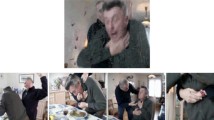Abstract
Motion can be an effective tool to focus user’s attention and to support the parsing of complex information in graphical user interfaces. Despite the ubiquitous use of motion in animated displays, its effectiveness has been marginal at best. The ineffectiveness of many animated displays may be due to a mismatch between the attributes of motion and the nature of the task at hand. To test this hypothesis, we examined different modes of route presentation that are commonly used today (e.g. internet maps, GPS maps, etc.) and their effects on the subsequent route memory. Participants learned a route from a map of a fictitious town. The route was presented to them either as a solid line (static) or as a moving dot (dynamic). In a subsequent memory task, participants recalled fewer pertinent landmarks (i.e. landmarks at the turns) in the dynamic condition, likely due to the moving dot that focused equally on critical and less important parts of the route. A second study included a combined (i.e. both static and dynamic) presentation mode, which potentially had a better recall than either presentation mode alone. Additionally, verbalization data confirmed that the static presentation mode allocated the attention to the task relevant information better than the dynamic mode. These findings support the hypothesis that animated tasks are conceived of as sequences of discrete steps, and that the motion in animated displays inhibits the discretization process. The results also suggest that a combined presentation mode can unite the benefits of both static and dynamic modes.
Access this chapter
Tax calculation will be finalised at checkout
Purchases are for personal use only
Preview
Unable to display preview. Download preview PDF.
Similar content being viewed by others
References
Agrawala, M. & Stolte, C. (2001). Rending effective route maps: improving usability through generalization. Proceedings of SIGGRAPH 2001.
Baus, J., Ding, Y, Kray, C., & Walther, U. (2001). Towards adaptive location-aware mobile assistants. Workshop notes on the IJCAI 2001 workshop on Artificial Intelligence in Mobile Systems.
Bartram, L. & Ware, C. (2002). Filtering and brushing with motion. Information Visualization. 1(1), 66–79.
Denis, M. (1997). The description of routes: A cognitive approach to the production of spatial discourse. Cahiers de Psychologie Cognitive, 16, 409–458.
Hegarty, M., Quilici, J., Narayanan, N. H., Holmquist, S., & Moreno, R. (1999). Multimedia instruction: Lesson from evaluation of a theory-based design. Journal of Educational Multimedia and Hypermedia, 8, 119–150.
Hirtle, S. C. (1999). The use of maps, images, and “gestures” for navigation (pp. 31–40). In C. Freksa, W. Brauer, C. Habel, K.F. Wender (eds.). Spatial cognition II, integrating abstract theories, empirical studies, formal methods, and practical applications. Springer: Berlin.
Jackson, P. G. (1998). In search for better route guidance instructions. Ergonomics, 41(7), 1000–1013.
Klippel, A., Tappe, H., & Habel, C. (in press). Pictorial representations of routes: Chunking route segments during comprehension. In C. Freksa, W. Brauer, C. Habel & K. Wender (eds.), Spatial Cognition III. Berlin: Springer.
Palmiter, S., & Elkerton, J. (1993). Animated demonstrations for learning procedural computerbased tasks. Human-Computer Interaction, 8(3), 193–216.
Tappe, H., & Habel, C. (1998). Verbalization of dynamic sketch maps: Layers of representation in the conceptualization of Drawing Events. Poster at Cognitive Science Conference. Madison WI.
Lee, P. U. & Tversky, B. (in preparation). Keeping the “goodness” in good directions and maps.
Tversky, B., Morrison, J. B., & Betrancourt, M. (2002). Animation: can it facilitate? International Journal of Human-Computer Studies, 57, 247–262.
Ward, S.L., Newcombe, N., & Overton, W.F. (1986). Turn left at the church or three miles north: A study of direction giving and sex differences. Environment and Behavior, 18, 192–213.
Zacks, J., Tversky, B., & Iyer, G. (2001). Perceiving, remembering, and communicating structure in events. Journal of Experimental Psychology: General, 130, 29–58.
Author information
Authors and Affiliations
Editor information
Editors and Affiliations
Rights and permissions
Copyright information
© 2003 Springer-Verlag Berlin Heidelberg
About this paper
Cite this paper
Lee, P.U., Klippel, A., Tappe, H. (2003). The Effect of Motion in Graphical User Interfaces. In: Butz, A., Krüger, A., Olivier, P. (eds) Smart Graphics. SG 2003. Lecture Notes in Computer Science, vol 2733. Springer, Berlin, Heidelberg. https://doi.org/10.1007/3-540-37620-8_2
Download citation
DOI: https://doi.org/10.1007/3-540-37620-8_2
Published:
Publisher Name: Springer, Berlin, Heidelberg
Print ISBN: 978-3-540-40557-3
Online ISBN: 978-3-540-37620-0
eBook Packages: Springer Book Archive




